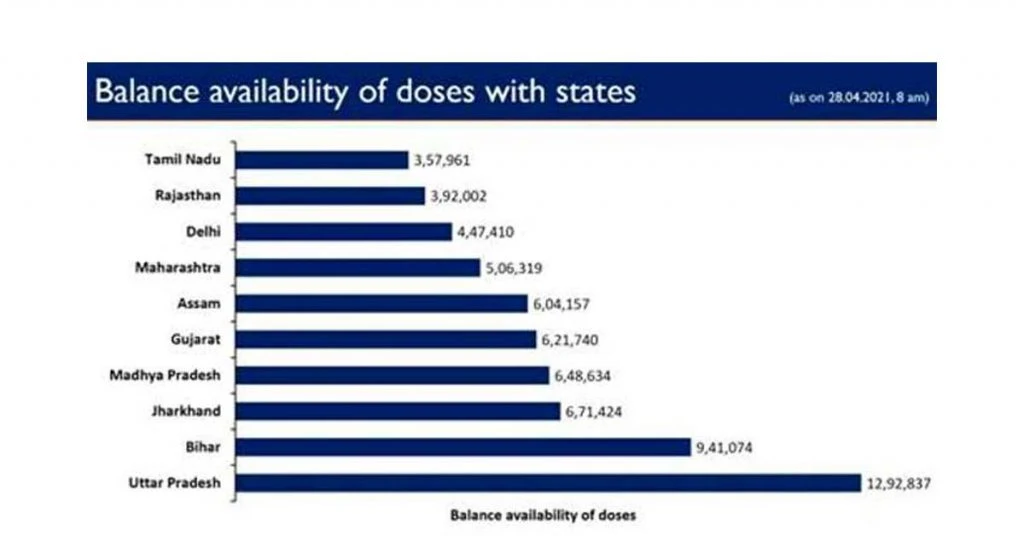Mass COVID Vaccination Drive: How to Overcome Logistics Management Hurdles

Vaccination has successfully eradicated or controlled the severity and spread of many diseases in the past. And now it’s time to build some immunity against the COVID-19 pandemic that has caused chaos worldwide.
India has recently approved double doses per person (18+ years) of indigenously manufactured Covishield and Covaxin with a gap of more than a month for vaccination coverage. The government has also approved Sputnik V vaccines for emergency use.
However, only 9.5 percent of the 1.35 billion people in India have been vaccinated till now. Even though India has the capacity to become one of the biggest vaccine manufacturers in the world.
India began with strategic vaccination of vulnerable and priority groups that included healthcare, armed forces, goods suppliers, and other essential service providers. Apart from them, there was a phased rollout of vaccines for those above 45 years of age and people suffering from comorbid conditions such as diabetes, cardiovascular issues, and hypertension.
However, with the surge of new variants of SARS-CoV-2, the vaccination rate seemed inefficient to curb the exponential rise in the recent COVID-19 cases, with the total number reaching almost 19 million.
India begins with a vaccination drive for adults between 18 to 45 years from 1st May. This constitutes the working group who have the highest potential of being super spreaders due to the need to go out for daily work.
In addition, despite being the biggest manufacturer of vaccines globally, the nation faces numerous logistics challenges that it needs to overcome to ensure speedy vaccine coverage of the masses.
Major Logistics Challenges with Mass COVID-19 Vaccination in India
The selection of COVID-19 vaccines was done based on timely availability, ease of storage, efficacy, the possibility of mass manufacturing, and availability of logistics. While the work by policymakers to fulfill the gaps in the phased vaccine rollouts has been rigorous, it is not enough.
The lockdown in many parts of the country has itself disrupted the supply and distribution of COVID-19 vaccines. The need to speed up infrastructure improvement and logistical arrangements come with numerous challenges, including financial ones. The bottlenecks to ensure equitable distribution of vaccines are overwhelming. Some of the major ones are discussed next.
Wastage During Storage & Transportation
Policymakers at the Centre and state/UT(s) and the private sector need to collaborate at multiple levels to ensure the efficient completion of tasks for vaccine deployment. More than 127 million doses have been administered till now. The existing vaccination distribution network is overburdened.
Manufacturing the vaccines is not enough. Accompanying non-vaccine components such as glass vials, syringes, and medical devices also need to be manufactured and supplied for every dosage.
To maintain the integrity and efficacy of vaccines, the storage facility at the manufacturing hub, the transportation facility, and the storage facility at the place of administration need to be temperature controlled (2-8 degrees Celsius). This requires reliable temperature monitoring equipment. The equipment management requires specialized technicians and handlers.
In addition, time dependency so that the administered vaccines do not get compromised makes it further difficult. If not done properly, it leads to the wastage of expensive vaccines and the unimaginable cost burden from re-vaccination. The total consumption by the states till now includes wastage of staggering 14.8 crore doses.

The government of India has also released a report of the amount of vaccine dosage getting wasted across different states and union territories.
To reach all people, vaccines need to be delivered timely in the country’s most remote villages. It requires transportation besides flights. The vaccine transportation facilities need to have temperature-controlled storage units.
The distribution of active facilities varies widely across states, and expansion of capacity to infrastructure-wise limited areas due to population density and accessibility, which are emerging as COVID-19 hotspots, is a demanding task. Moreover, besides being a logistical and financial issue, ramping up the capacity cannot be done without maintaining quality checks.
Shortage of the Medical Personnel
In India, doctors and trained nurses administer vaccines to individuals. The number of nursing personnel in the country is far below the standard World Health Organization (WHO) norm of maintaining a ratio of 3 per 1000.
Primary healthcare centers (PHCs) are not distributed uniformly across the country, with a complete shortage in distant towns or villages. The government has opted for a site-based drive just like the voting process since the door-to-door service is not feasible in such a risky situation.
The vaccination program not only requires several health workers at each location, but it also needs to be ensured that the workers are skilled enough.
Monitoring of the Inoculation Process
Monitoring a program of this scale and complexity at different levels is a complex process. This is necessary to ensure that vaccines get manufactured, transported, and stored as per internationally recognized safety norms.
Tracking and documenting the number of people and doses is necessary to prevent instances of duplication and hoarding. Having medical records for a certain section of the population and making decisions for everyone based on that can skew judgment.
The CoWIN (COVID-19 Vaccine Intelligence Network) database for vaccine registration is employed to plan, implement, monitor, and evaluate the Covid-19 vaccination delivery system. It was developed on the existing platform of the electronic Vaccine Intelligence Network (eVIN) module.
The system does not involve any element of outreach and engagement by the government. The server faced issues immediately after registration for the 18+ group opened, but it was fixed in time.
Suggested Read: Supply Chain Management Software | Courier Management Software | Delivery Management Software
5 Ways to Overcome Logistics Challenges
Social distancing, wearing masks, handwashing are the precautions, to begin with, to reduce transmission speed. This will reduce the burden of our overburdened system from Covid-19 vaccine drive and pre-existing immunization programs. But, unfortunately, one strategy cannot fit every country, and the health care delivery system cannot be upgraded in a week or two.

The peculiarities of India require unique implementation strategies to solve the existing gaps in the supply chain and deal with logistics hurdles. To strengthen the supply chain and distribution capacity, the following measures can be taken going forward.
Increase In Centre-State Collaboration
Governments at the state and Centre have been coordinating to put operational guidelines and training programs in place everywhere. But there needs to be a lot of micro-level planning for purposes such as organizing session sites nearer to the population settings.
From the place of origin to the destination, the service-delivery model needs to account for uncertainties. This requires governments not to blame each other but rather look at the challenges together via efficient communication channels.
Center can transfer the funds to states either as grants or as special long-term loans to states for the vaccination drive as many states have announced free vaccines to the people. Centre needs to provide support while state governments need to provide comprehensive online training programs to more health personnel for storing, transporting, and administering the vaccination.
Only then the government’s ambitious goal to cover such a large section of the population in a short time will be fulfilled.
The health workers already know the basics of how vaccines work, but they should be able to immediately report any side effects or adverse events to the authorities. There are several disparities among various states that should be managed effectively. States like Jharkhand, Uttar Pradesh, and Madhya Pradesh should be allocated proper resources.
Preventing the Scope of Miscommunication & Data Security Threat
Government must monitor that everything being used follows regulatory authorization and approval as many individuals and groups can feed on the misinformation and fear among people to meet their malicious goals.

Traditionally, documentation, tracking, and safety monitoring have not been done efficiently during vaccinations. CoWIN is likely to help identify beneficiaries and record their first dosage and the second one. The number of hospitals registered on CoWIN must be increased. Additional tracking support like data on tags from COVID-19 vaccine batches can also be used.
However, the data is at the risk of cyberattacks, and governments need to take measures so that everything functions smoothly. Many fake CoWIN sites have collected personal information from Indian users and used it for a data breach.
Planned Approach from Logistics Service Providers
Robust new systems and infrastructure are necessary for subsequent phases after manufacturing. The network of warehouses and transportation capabilities needs to be strengthened. The needs are far greater than any other existing immunization drive.
Logistics players need to collaborate with government bodies at different levels-Centre, state/UTs, and district to handle the challenges successfully. Besides transportation, the focus needs to be on packaging, handling, and storage at the destination point.
Sanitization also needs to be taken care of at each stage and cannot be compromised in any form. The companies need to assess if there are gaps in skills or management and take necessary action.
In India, vaccines and critical medical supplies like PPE kits and masks to mobile vaccination sites across remote destinations and multiple states need a well-coordinated multimodal transportation network. The importance was visible in the recent delivery of oxygen tankers after hospitals in the national capital ran out of supplies for treatment.
The vehicles used must be able to fulfill strict requirements in terms of temperature control and other pieces of equipment. Such states like Uttar Pradesh are looking for ways like repurposed refrigerated vans from other sectors for transportation.
The companies need to ensure that proper standards are followed and shipments do not stop for any reason. In addition, the time taken for Approval of private hospitals for vaccination needs to be reduced for adequate availability of manpower.
Increased Usage of Logistics Management Software
Logistics companies involved in delivering Covid-19 vaccines are using their own logistics software. Logistics management software helps with batch-wise traceability and accurate data collection needed for making smart decisions. The government has used the CoWIN platform for efficient vaccine logistics management since its launch.
Besides the CoWIN software numerous other logistics management software providers cater to the logistics management needs for the COVID-19 vaccine. For instance, LogiNext company launched the transportation automation SaaS (software as a service) platform.
The software provides a dashboard to keep track of vaccine movement from the point of manufacturing to the final delivery destination in real-time. This helps in better management of vaccine distribution.
Even globally outside India, logistics software such as the Tiberius platform and Everbridge software are being used to deliver vaccines safely.
A Big Shout Out to Global Cooperation
Just like researchers worldwide came together to speed up the vaccine creation process, vaccine delivery also needs global collaboration.
The distribution capacity of the public sector needs to be increased. Though indigenous cold chain companies (like the largest one, Snowman Logistics or ColdStar Logistics) themselves are highly capable, working together with some global names like Amazon, United Parcel Service (UPS), and FedEx Corporation will further ensure that the process is smooth.
Many countries like the USA, UK, Canada, Germany, Kuwait, France, and Russia have already come to support the procurement of essential supplies and medicines.
Moreover, CoWIN app is developed in partnership with UNDP, which is United Nations Development Program to rack the storage and distribution of vaccines.
Using technologies like drones can help in monitoring and supplying the necessities in containment zones and remote areas. This way, the country will be able to make high-performance cold chain vehicles, storage units, and shipping pallets available everywhere.
Ayushee is currently pursuing MBA Business Analytics from SCMHRD, Pune with a strong background in Electronics and Communication Engineering from IGDTUW. She has 2 plus years of full-time work experience as an SEO content writer and a Technology Journalist with a keen interest the amalgamation of business and... Read more




























